About Scatter Plot Templates
A Template is a predefined Scatter Plot diagram with set axes and graphical categorization elements. Each Template consists of three files:
- The Template file, "*.geosoft_template", which is a text file that contains information on, for example the channels, scales and titles, as well as the name of the associated overlay file.
- The Overlay file, "*.geosoft_overlay", which is a text file that contains either (i) line/text commands to draw an overlay or (ii) the name of a map file to use as the overlay. In this case, it refers to a map file.
- The Map file, "*_Overlay.map", which is a Geosoft map containing the overlay map items.
These files are stored in the "…/Geosoft/resourcefiles/etc" folder. New or modified Templates and Overlays are stored in the "…/Geosoft/user/etc" folder.
Twenty-eight Bivariate Diagram (Scatter Plot) Templates are included with montaj Geochemistry. They are divided into three categories: Lithological Discrimination, Diamond Exploration and Uncategorized.
Lithological Discrimination Diagrams
The lithological discrimination diagrams include a combination of major and trace element diagrams, as well as some that are useful for volcanic and some that are useful for plutonic rock types.
Al2O3 vs TiO2 - Distinguishes between Within-plate and Arc-related sources
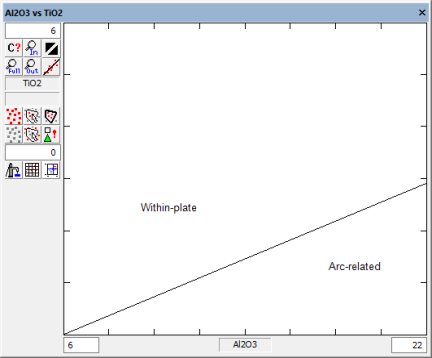
Ga vs Zr_TiO2 - For volcanic discrimination; classifies samples according to major volcanic rock types
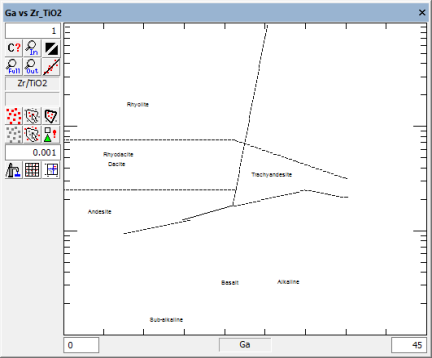
Gax10000_Al vs Zr - For granitic discrimination; distinguishes between A-type granites (within plate), and I&S-type (syn-collisional and volcanic arc) granites
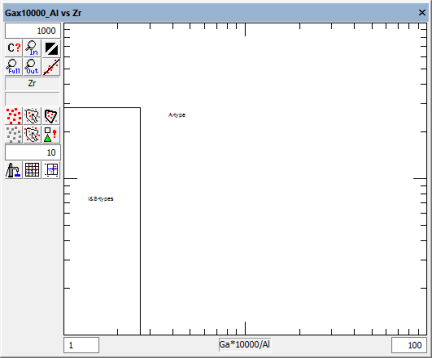
Nb_Y vs SiO2 - For volcanic discrimination; classifies samples according to major volcanic rock types using Nb/Y (as an alkalinity indicator) vs SiO2. (After Winchester and Floyd, 1977)

Nb_Y vs Ti_Y - For basalt discrimination; distinguishes between within-plate basalts, MORB and volcanic-arc basalts (dashed line). (After Pearce, 1982)
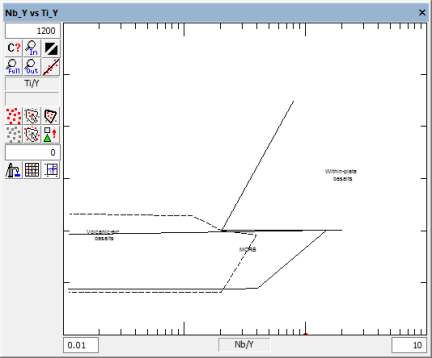
Nb_Y vs Zr_TiO2 - For alkaline /sub-alkaline basalt discrimination. (After Winchester and Floyd, 1977)
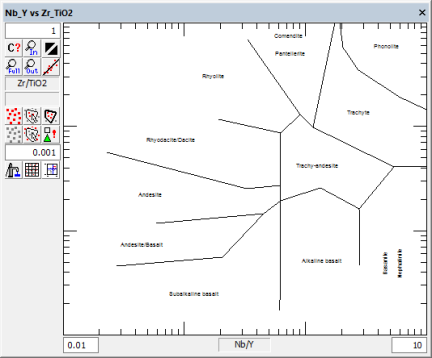
SiO2 vs K2O - For the subdivision of subalkalic rocks. Broken lines and italic labels are after Le Maitre et al., 1989; Labels in parenthesis are after Rickwood, 1989; the shaded bands denote the regions where various boundary lines fall, as summarized by Rickwood, 1989 (lines from Peccerillo and Taylor, 1976; Ewart, 1982; Innocenti et al., 1982; Carr, 1985; and Middlemost, 1985).

SiO2 vs Na2O+K2O plutonic - For the classification of plutonic rocks using total alkalis vs silica (TAS diagram). (After Cox et al., 1979; Wilson, 1989)
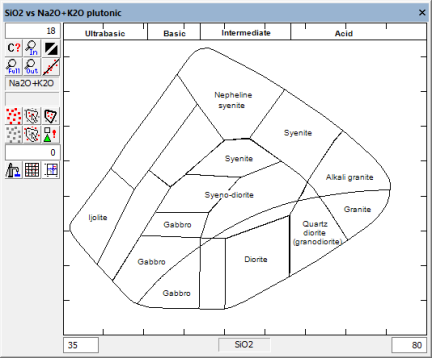
SiO2 vs Na2O+K2O volcanic - For the classification of volcanic rocks using total alkalis vs silica (TAS diagram). (After Le Maitre, 1989)
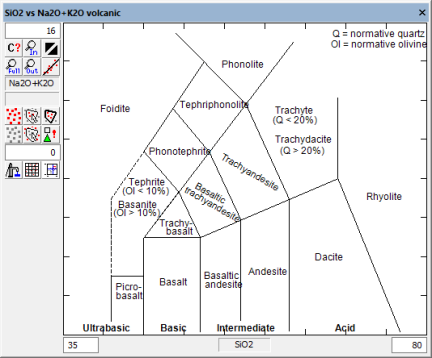
Ti_1000 vs V - For discriminating basalts; groupings are: arc tholeiite, MORB and back-arc basin, and alkali basalts. (After Shervais, 1982)
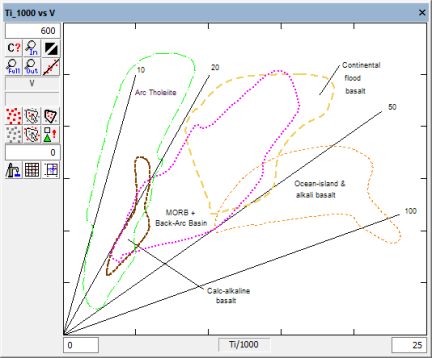
TiO2_Al2O3 vs Zr_Al2O3 - Distinguishes between Within-plate and Arc-related sources
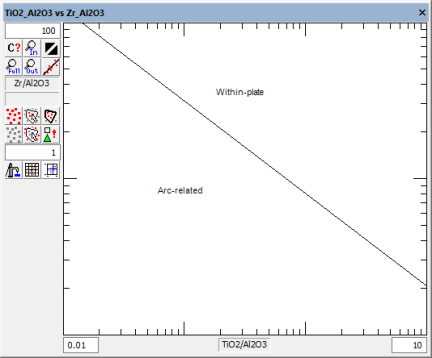
Y vs Nb - Discrimination diagram for granites, showing fields for volcanic-arc granites, within-plate granites, and ocean-ridge granites. (After Pearce et al., 1984)
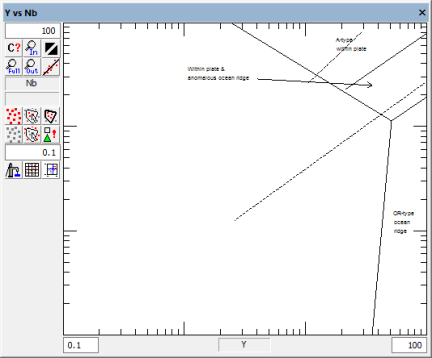
Yb vs La_Yb - For differentiation of basalts into calc-alkaline, transitional and tholeiitic
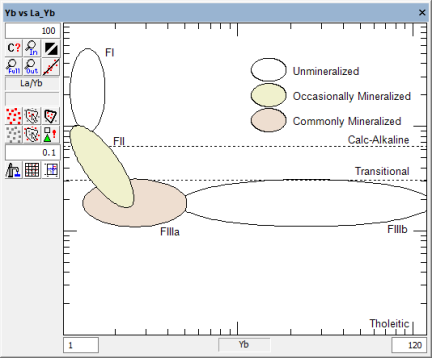
Zr vs Nb - For basalt discrimination; shows increasing within-plate enrichment.
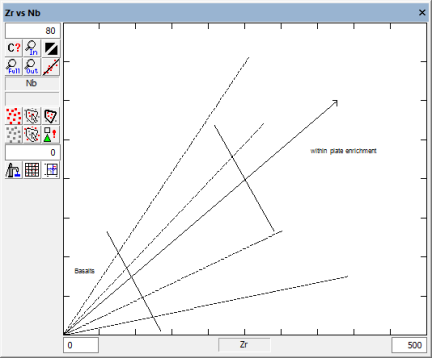
Zr vs TiO2 - Idealized fractionation curves for immobile elements in a tholeiitic volcanic suite. (After MacLean and Barrett, 1993)

Zr vs Y - For differentiation of basalts into calc-alkaline, transitional and tholeiitic.
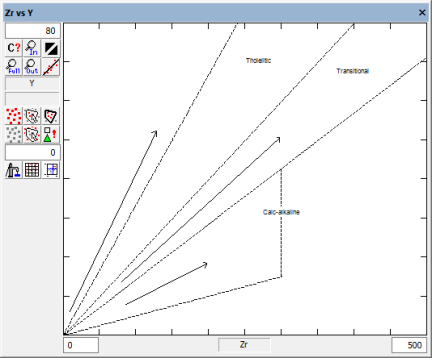
Zr vs Zr_Y - Discrimination for basalts based on Zr/Y-Zr variations.
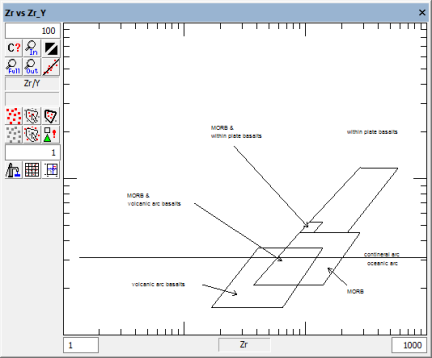
Diamond Exploration Diagrams
Chromite_Cr2O3-MgO - For Chromite classification; this diagram identifies and separates mantle trend kimberlites from those with compositions more likely to contain diamond inclusions. (After Gurney et al., 1993; Fipke et al., 1995)
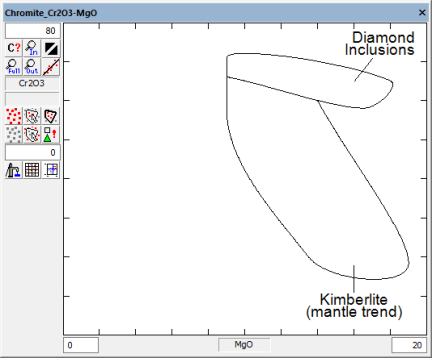
Chromite_TiO2-Cr2O3 - For Chromite classification; this diagram distinguishes between garnet-bearing and garnet free assemblages, and contains fields to separate Kimberlitic, Lamroitic and Non-Kimberlitic and Non-Lamproitic rock types. (After Fipke, 1994; Grutter & Apter, 1998)
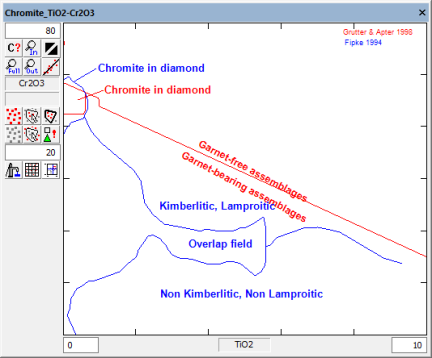
Garnet_Gurney - For Garnet classification; this diagram classifies mantle-derived garnets on the basis of Cr2O3 and CaO content. Garnets are grouped by G-number, where G10 garnets (Harzburgitic) are within the diamond facies. (After Gurney, 1984)
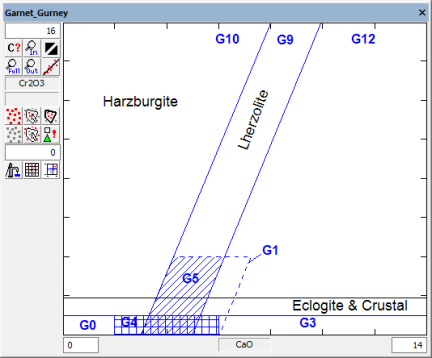
Garnet_TiO2-Cr2O3 - For Garnet classification; this diagram identifies the boundary between perioditic and megacrystic garnets. (After Schulze, 2003)
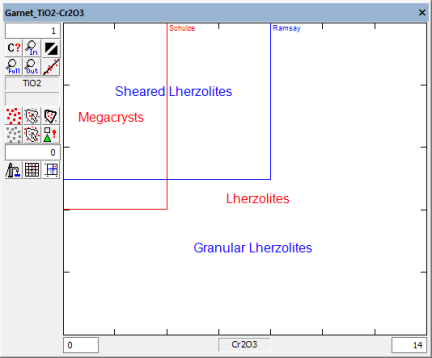
Garnet_TiO2-Na2O - For Garnet classification; this diagram identifies eclogitic and megacrystic type garnets. (After Fipke et al., 1995)
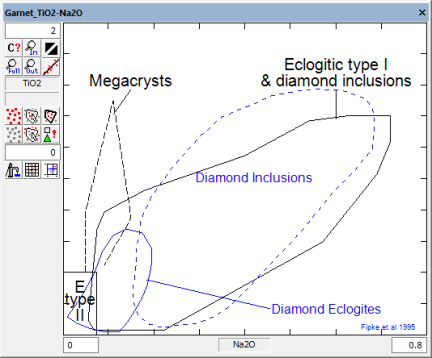
Ilmenite_Cr2O3-MgO - For Ilmenite classification; this diagram identifies basaltic ilmenites
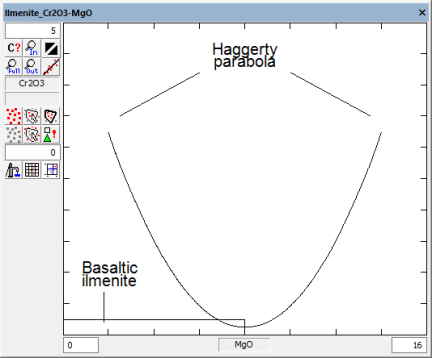
Ilmenite_TiO2-MgO - For Ilmenite classification; this diagram separates kimberlitic ilmenites from non-kimberlitic ilmenites. (After Wyatt et al., 2004)
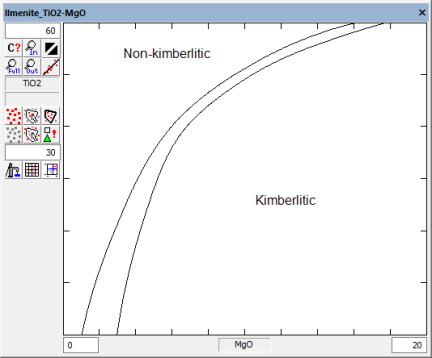
Pyroxene_CaOMgO-Al2O3 - For Pyroxene classification; this diagram separates pyroxenes into various categories: garnet bearing peridotite, spinel peridotite, megacrysts (on- and off-craton).

Pyroxene_Cr2O3-Al2O3 - For Pyroxene classification; this diagram distinguishes between garnet peridotite, spinel peridotite, eclogite and megacrysts.

Uncategorized
Nb_Y vs Ga_Sc - For volcanic classification
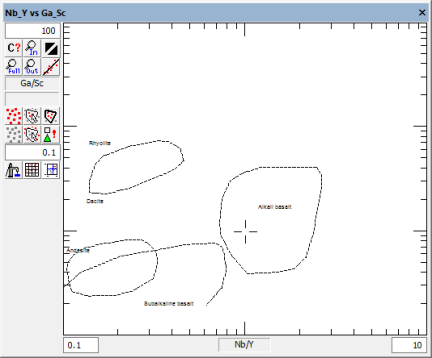
Y vs Zr_Y - For differentiation of basalts into calc-alkaline, transitional and tholeiitic groups
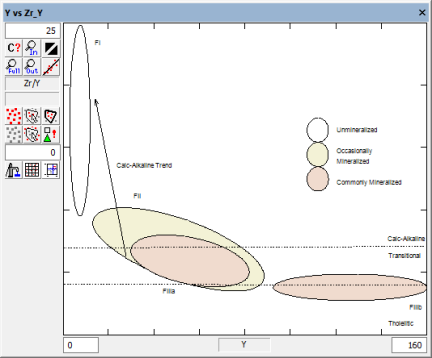
Diagram descriptions based on:
Rollinson, H.R., 1993. Using Geochemical Data: Evaluation, Presentation, Interpretation. Longman, London.
References
Cox, K. G., Bell, J. D. & Pankhurst, R. J., 1979. The Interpretation of Igneous Rocks. George Allen & Unwin.
Ewart, A., 1982. The mineralogy and petrology of Tertiary-Recent orogenic volcanic rocks: with special reference to the andesitic-basaltic compositional range. In: R.D.Thorpe (Editor), Andesites: Orogenic Andesites and Related Rocks. Wiley, Chichester, pp. 26-87.
Feigenson, M.D., and Carr, M.J., 1985. Determination of major, trace, and rare-earth elements in rocks by DCP-AES: Chemical Geology, v. 51, p. 19-27.
Fipke, C.SE., 1994. Significance of chromite, ilmenite, G5 Mg-almandine garnet, zircon, and tourmaline in heavy mineral detection of diamond-bearing lamproite. Proceedings of the 5th International Kimberlite Conference. Vol. 2. Diamonds, Characterization, Genesis and Exploration. Companhia de Pesquisa de Recursos Minerais, Rio de Janeiro, Brazil. 366-381.
Fipke, C.E., Gurney, J.J. and Moore, K.O., 1995. Diamond exploration techniques emphasizing indicator mineral geochemistry and Canadian examples; Geological Survey of Canada, Bulletin 423, 85 pages.
Gurney, J.J., 1984. A correlation between garnets and diamonds in kimberlites. In: Glover, J.E., Harris, P.G. (Eds.), Kimberlite Occurrence and Origin: A Basis for Conceptual Models in Exploration. Geology Department and University Extension, University of Western Australia, Publication, vol. 8. Blackwell Scientific Publications, Perth, pp. 143-166.
Gurney, J.J, Helstaedt, H., Moore, R.O., 1993. A review of the use and application of mantle mineral geochemistry in diamond exploration. Pure and Applied Chemistry 65, 2423-2442.
Grütter, H.S. and Apter, D.B., 1998. Kimberlite and lamproite-borne chromite phenocrysts with “diamond inclusion”- type chemistries; Extended Abstract; 7th International Kimberlite Conference, South Africa, pages 280-288.
Innocenti , F., Mazzuoli, R., Pasquale, G., Radicati di Brozolo, F., and Villari, L., 1982. Tertiary and Quaternary volcanism of the Erzurum-Kars area (eastern Turkey): Geochronological data and geodynamic evolution: Journal of Volcanology and Geothermal Research, v. 13, p. 223-240.
Le Maitre, R. W., Bateman, P., Dudek, A., Keller, J., Lameyre, J., Le Bas, M. J., Sabine, P. A., Schmid, R., Sorensen, H., Streckeisen, A., Woolley, A. R. & Zanettin, B., 1989. A Classification of Igneous Rocks and Glossary of Terms: Recommendations of the International Union of Geological Sciences Subcommission on the Systematics of Igneous Rocks. Oxford: Blackwell Scientific.
MacLean, W.H. and Barrett, T.J., 1993. Lithogeochemical techniques using immobile elements; Journal of Exploration Geochemistry, v.48, p. 109-133.
Middlemost, E. A. K., 1985. Magmas and Magmatic Rocks. London: Longman.
Middlemost, E. A. K., 1985. Naming materials in the magma/igneous rock system. Earth-Sciences Reviews 37, 215–224.
Pearce, J. A., Harris, N. B. W., and Tindle, A. J., 1984. Trace element discrimination diagrams for the tectonic interpretation of granitic rocks. J. Petrol., 25, 956-83.
Pearce, J.A., 1982. Trace element characteristics of lavas from destructive plate boundaries; Andesites, 525-548.
Peccerillo, A. & Taylor, S. R., 1976. Geochemistry of Eocene calc-alkaline volcanic rocks from the Kastamonu area, Northern Turkey. Contributions to Mineralogy and Petrology 58, 63–81.
Rickwood, P., 1995. Boundary lines within petrologic diagrams which use oxides of major and minor elements; Lithos , vol. 22, no. 4, pp. 247-263.
Schulze, D.J., 2003. A classification scheme for mantle-derived garnets in kimberlite: a tool for investigating the mantle and exploring for diamonds; Lithos, Volume 71, pages 195–213.
Shervais, J.W., 1982. Ti–V plots and the petrogenesis of modern ophiolitic lavas. Earth Planet. Sci. Lett. 59, 101–118.
M. Wilson, 1989. Igneous Petrogenesis. A Global Tectonic Approach. xx + 466 pp.
Winchester, J.A. and Floyd, P.A., 1977. Geochemical discrimination of different magma series and their differentiation products using immobile elements. Chem. Geol., 20: 325--343.
Wyatt, B.A., Baumgartner, M., Ancar, E. and Grütter, H., 2004. Compositional classification of “kimberlitic” and “non-kimberlitic” ilmenite; Lithos, Volume 77, pages 819–840.
Got a question? Visit the Seequent forums or Seequent support
© 2023 Seequent, The Bentley Subsurface Company
Privacy | Terms of Use
